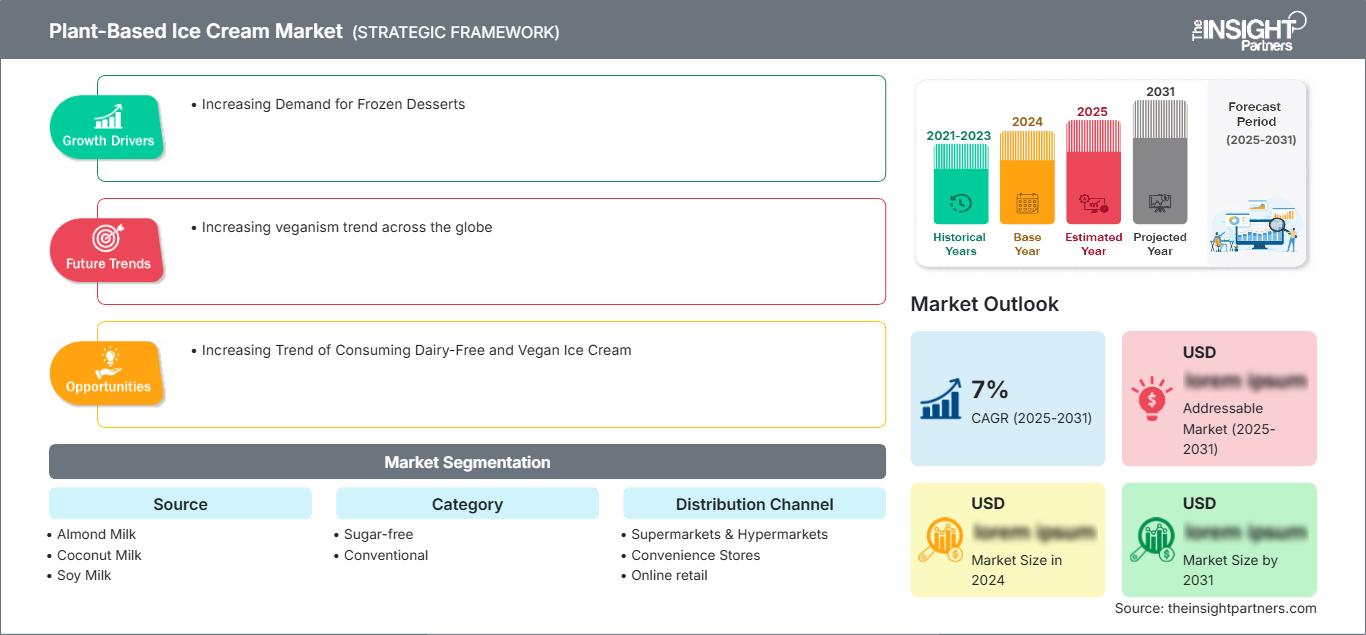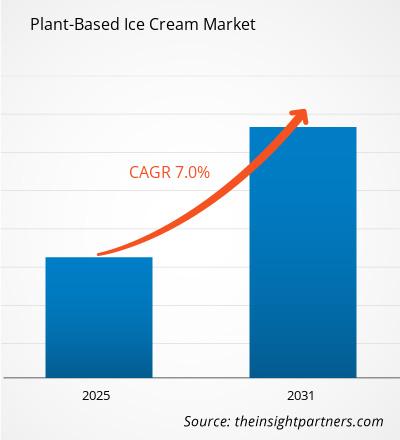Der Markt für pflanzliches Speiseeis wird zwischen 2023 und 2031 voraussichtlich eine durchschnittliche jährliche Wachstumsrate (CAGR) von 7 % verzeichnen. Der weltweit zunehmende Trend zum Veganismus wird voraussichtlich ein wichtiger Trend auf dem Markt bleiben.
Marktanalyse für pflanzliches Speiseeis:
- Ein wichtiger Faktor ist die ständig wachsende Zahl laktoseintoleranter Menschen, die die Nachfrage nach einer milchfreien Alternative ankurbeln.
- Darüber hinaus steigt das Gesundheits- und Wellnessbewusstsein der Verbraucher, was wiederum das Wachstum veganer und pflanzlicher Produkte fördert. Marktteilnehmer produzieren und vermarkten neue Geschmacksrichtungen und Sorten veganen Eises, die den Markt wachsen lassen.
- Produkteinführungs- und Entwicklungsstrategien wichtiger Marktteilnehmer auf dem Markt für pflanzliches Eis schaffen lukrative Wachstumschancen.
Marktübersicht für pflanzliches Eis
- Das Marktwachstum für pflanzliches Eis ist auf verschiedene Faktoren zurückzuführen, wie die zunehmende Verbreitung von Laktoseintoleranz, das zunehmende Gesundheitsbewusstsein der Verbraucher und die wachsende Zahl veganer Menschen. Die gesundheitlichen Vorteile, die mit dem Verzehr angereicherter und nahrhafter Lebensmittel verbunden sind, sowie die Entwicklung neuer Geschmacksrichtungen und alternativer Sorten für das Eiscremesegment katalysieren das Wachstum des Eiscrememarktes.
- Nordamerika war 2023 aufgrund des wachsenden Gesundheitsbewusstseins und der zunehmenden Präferenz für vegane und pflanzliche Produkte führend auf dem Markt für pflanzliches Eis.
- Der Markt für pflanzliches Eis im asiatisch-pazifischen Raum wird voraussichtlich weltweit das höchste Marktwachstum verzeichnen, da der Trend zu einem gesunden Lebensstil zunimmt.
- Zu den wichtigsten Akteuren auf dem Weltmarkt zählen unter anderem Unilever Plc, Nestle SA, Wells Enterprises, Inc., Happy Cow Limited und Eden Creamery LLC.
Passen Sie diesen Bericht Ihren Anforderungen an
Sie erhalten kostenlos Anpassungen an jedem Bericht, einschließlich Teilen dieses Berichts oder einer Analyse auf Länderebene, eines Excel-Datenpakets sowie tolle Angebote und Rabatte für Start-ups und Universitäten.
Markt für pflanzliches Eis: Strategische Einblicke

-
Holen Sie sich die wichtigsten Markttrends aus diesem Bericht.Dieses KOSTENLOSE Beispiel umfasst Datenanalysen, die von Markttrends bis hin zu Schätzungen und Prognosen reichen.
- Das steigende verfügbare Einkommen und die Einführung verschiedener Produkte in der Kategorie Dessert, um den Wünschen einer großen Verbrauchergruppe gerecht zu werden, treiben den Speiseeismarkt an. Der sprunghaft ansteigende Konsum hochwertiger gefrorener Desserts ist einer der größten Trends in der Lebensmittelindustrie.
- Die Entwicklung und Beliebtheit dieser gefrorenen Desserts wird vielen gesellschaftlichen Veränderungen zugeschrieben, wie der wachsenden Zahl kleinerer Haushalte und der wachsenden Zahl der Millennials weltweit. Diese Faktoren lassen die Nachfrage der Verbraucher nach gefrorenen Desserts wie Speiseeis deutlich steigen.
- Die zunehmende Anzahl von Produkteinführungen im Segment der gefrorenen Desserts, wie Vanillesoße, Joghurt, Gelato, Granita, Eiscreme und Sorbet, treiben den Speiseeismarkt an.
Zunehmender Trend zum Konsum von milchfreiem und veganem Speiseeis
- Der Veganismus hat in den letzten Jahren deutlich an Dynamik gewonnen. Verbraucher bevorzugen pflanzliche Produkte, da sie diese als gesünder als konventionelle Produkte empfinden. Das zunehmende Bewusstsein für Tierschutz und ökologische Nachhaltigkeit trägt zudem zur Beliebtheit dieser Lebensmittel bei.
- Die weltweite Verbreitung des Veganismus beeinflusst Innovationen auf dem Speiseeismarkt stark. Laut Daten von Veganuary, einer gemeinnützigen Organisation, die Menschen dazu ermutigt, den gesamten Januar über vegan zu leben, haben sich im Jahr 2021 rund 5,8 Millionen Menschen für die „Veganuary-Kampagne“ angemeldet.
- Die Anmeldungen für die Veganuary-Kampagne haben in den letzten Jahren dramatisch zugenommen. Aufgrund des florierenden Trends zum Veganismus bringen die Hersteller von gefrorenen Desserts wie Eiscreme pflanzliche Produkte auf den Markt.
Marktsegmentierung für pflanzliche Eiscreme
Der Umfang des globalen Marktes für pflanzliche Eiscreme wurde nach Zutatentyp und Anwendung segmentiert.
- Basierend auf der Quelle ist der Markt für pflanzliche Eiscreme in Mandelmilch, Kokosmilch, Sojamilch und andere unterteilt.
- In Bezug auf die Kategorien ist der Markt in Bio und konventionell unterteilt.
- Basierend auf dem Vertriebskanal ist der Markt in Supermärkte und Hypermärkte, Convenience Stores, Online-Einzelhandel und andere.
Marktanteilsanalyse für pflanzliches Speiseeis nach geografischer Lage
- Der Marktbericht für pflanzliches Speiseeis enthält eine detaillierte Analyse der fünf wichtigsten geografischen Regionen, einschließlich der aktuellen und historischen Marktgröße sowie Prognosen für 2021 bis 2031 für Nordamerika, Europa, den asiatisch-pazifischen Raum (APAC), den Nahen Osten und Afrika (MEA) sowie Süd- und Mittelamerika.
- Jede Region ist weiter in entsprechende Länder unterteilt. Dieser Bericht bietet Analysen und Prognosen für über 18 Länder und deckt die Marktdynamik für pflanzliches Speiseeis ab, wie z. B. Treiber, Trends und Chancen, die die Märkte auf regionaler Ebene beeinflussen.
- Darüber hinaus umfasst der Bericht Porters Fünf-Kräfte-Analyse, die die Untersuchung der wichtigsten Faktoren umfasst, die den Markt für pflanzliches Speiseeis in diesen Regionen beeinflussen.
Markt für pflanzliches Speiseeis
Die Analysten von The Insight Partners haben die regionalen Trends und Faktoren, die den Markt für pflanzliches Speiseeis im Prognosezeitraum beeinflussen, ausführlich erläutert. In diesem Abschnitt werden auch die Marktsegmente und die geografische Lage für pflanzliches Speiseeis in Nordamerika, Europa, im asiatisch-pazifischen Raum, im Nahen Osten und Afrika sowie in Süd- und Mittelamerika erörtert.Umfang des Marktberichts über pflanzliches Speiseeis
| Berichtsattribut | Einzelheiten |
|---|---|
| Marktgröße in 2024 | US$ XX million |
| Marktgröße nach 2031 | US$ XX Million |
| Globale CAGR (2025 - 2031) | 7% |
| Historische Daten | 2021-2023 |
| Prognosezeitraum | 2025-2031 |
| Abgedeckte Segmente |
By Quelle
|
| Abgedeckte Regionen und Länder |
Nordamerika
|
| Marktführer und wichtige Unternehmensprofile |
|
Marktdichte von pflanzlichem Speiseeis: Auswirkungen auf die Geschäftsdynamik verstehen
Der Markt für pflanzliches Speiseeis wächst rasant, angetrieben von der steigenden Nachfrage der Endverbraucher aufgrund von Faktoren wie sich entwickelnden Verbraucherpräferenzen, technologischem Fortschritt und einem größeren Bewusstsein für die Vorteile des Produkts. Mit steigender Nachfrage erweitern Unternehmen ihr Angebot, entwickeln Innovationen, um den Bedürfnissen der Verbraucher gerecht zu werden, und nutzen neue Trends, was das Marktwachstum weiter ankurbelt.

- Holen Sie sich die Markt für pflanzliches Eis Übersicht der wichtigsten Akteure
Der Markt für pflanzliches Speiseeis wird durch die Erhebung qualitativer und quantitativer Daten aus Primär- und Sekundärforschung bewertet, die wichtige Unternehmenspublikationen, Verbandsdaten und Datenbanken umfasst. Im Folgenden finden Sie eine Liste der Entwicklungen auf dem Markt für Innovationen, Geschäftserweiterungen und Strategien:
- Ben & Jerry’s bringt eine neue Haferbasis für sein milchfreies Speiseeis auf den Markt. Die neue milchfreie Eisbasis wird im Frühjahr 2024 in Bechern und Eisdielen erhältlich sein. (Februar 2024, Pressemitteilung des Unternehmens).
Bericht zum Markt für pflanzliches Speiseeis: Abdeckung und Ergebnisse
Der „Markt für pflanzliches Speiseeis, Größe und Prognose (2021 – 2031)“ bietet eine detaillierte Analyse des Marktes, die die folgenden Bereiche abdeckt:
- Marktgröße und Prognose für Speiseeis auf pflanzlicher Basis auf globaler, regionaler und Länderebene für alle abgedeckten wichtigen Marktsegmente
- Markttrends für Speiseeis auf pflanzlicher Basis sowie Marktdynamik wie Treiber, Einschränkungen und wichtige Chancen
- Detaillierte PEST/Porters Five Forces- und SWOT-Analyse
- Marktanalyse für Speiseeis auf pflanzlicher Basis, die wichtige Markttrends, globale und regionale Rahmenbedingungen, wichtige Akteure, Vorschriften und aktuelle Marktentwicklungen umfasst
- Branchenlandschaft und Wettbewerbsanalyse, die Marktkonzentration, Heatmap-Analyse, prominente Akteure und aktuelle Entwicklungen für den Markt für Speiseeis auf pflanzlicher Basis umfasst
- Detaillierte Unternehmensprofile
- Historische Analyse (2 Jahre), Basisjahr, Prognose (7 Jahre) mit CAGR
- PEST- und SWOT-Analyse
- Marktgröße Wert/Volumen – Global, Regional, Land
- Branchen- und Wettbewerbslandschaft
- Excel-Datensatz
Aktuelle Berichte
Erfahrungsberichte
Grund zum Kauf
- Fundierte Entscheidungsfindung
- Marktdynamik verstehen
- Wettbewerbsanalyse
- Kundeneinblicke
- Marktprognosen
- Risikominimierung
- Strategische Planung
- Investitionsbegründung
- Identifizierung neuer Märkte
- Verbesserung von Marketingstrategien
- Steigerung der Betriebseffizienz
- Anpassung an regulatorische Trends






















 Kostenlose Probe anfordern für - Markt für pflanzliches Eis
Kostenlose Probe anfordern für - Markt für pflanzliches Eis